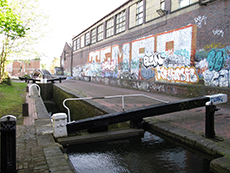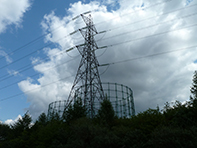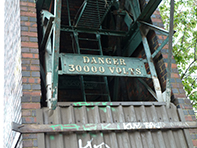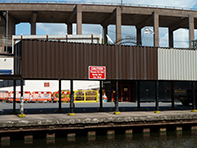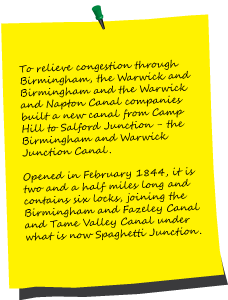
This was once, and to some extent still is, a highly industrialized area with carriage works, engine sheds, electro-platers, paper mills and various other Victorian enterprises lining the canal. Several local gas works relied on coal delivered by barges to manufacture ‘town gas’. There's no trace of them now but, when constructed in 1885, the gas holders at the Windsor St. works were the largest in the world
Modern flats eventually break up the industrial monotony, these boast adjacent moorings but this is not a tourist hot spot and traffic on the canal since Catherine de Barnes is liable to be non-existent. As you continue, note the red hatches on some of the older bridges. During WW2 enemy planes could follow the canals by moonlight to bomb the country's primary manufacturing centre and these hatches allowed fire engines to extract water from the canal.
The area around Garrison Top Lock can be quiet if not pretty. But the reality is that you are boxed in by roads and railways and soon again enveloped in the sights, sounds and smells of industry. Crashing and banging from a giant scrap yard needs to be heard to be believed as the canal descends through the next four locks. Saltley Dock is where Fellows, Morton and Clayton once had their main boat building operation and the seemingly endless urban activity continues until bridge 108 when the canal straightens along a paint plastered wall but is no longer so industrially claustrophobic.
There's a big paper recycling facility next to the Saltley Narrows on the far side of the River Rea which runs parallel to the canal but, once across an aquaduct over the river, there are playing fields and surprisingly a wildlife pond. You then pass Star City which offers safe moorings and was built on the site of the city's sewage works before it re-located to Minworth.
Just before Salford Junction the canal narrows to a boat width, this is Nechells Shallow or Stop Lock. Presumably the original lock cottage didn’t require protective razor wire. The end of the Grand Union is nigh when it meets the Tame Valley and the Birmingham and Fazeley canals under Spaghetti Junction which took eleven years to plan, four years to build and used 13,000 tonnes of steel with 175,000 cubic yards of concrete. It opened to traffic in 1972.
On the far side of the canal was the HQ of boatbuilders and carriers T & S Element who in the 1930s and 40s operated around 200 craft loaded with a huge variety of industrial products but by the 1970s this was reduced to six carrying factory rubbish. There was also fuel merchants and boatbuilders Spencer, Abott & Co. which was established in 1913 by Howard Spencer, a player and then director from Aston Villa's golden era, who was nicknamed 'The Prince of Full Backs'.
Salford Junction epitomises the fate of water transport, a 19th century landscape that is now dwarfed by the 21st, three canals carrying pathetically little traffic hidden beneath Spaghetti Junction with its eighteen intertwined roads that carry 200,000 vehicles every day.
This was a journey partly inspired by Robert Longden’s fabulous photographs
collected in 'A Canal People'. Planning the walk was made a lot easier by www.canalplan.org.uk and background information came from a range of sources including: http://mkiwa.users.btopenworld.com/route.htm, https://tringlocalhistory.org.uk
www.aghs.jimdo.com/transport-history/canal-history/, www.visitwarwick.co.uk/ www.wikipedia.org, www.localhistories.org/warwick.html
www.subbrit.org.uk/sb-sites/sites/w/weedon/index.shtml
www.saltisfordcanal.co.uk/Saltisford_Canal/History_of_the_Canal.html
www.brumagem.co.uk/Canals_Birmingham.htm, www.bsatrust.org, www.typhootea.com www.gunproof.com www.jquarter.org.uk, www.londoncanals.co.uk, Waterways World andwww.birmingham-canalwalks.co.uk
Text and photographs by The Canal Walker (email: martyn.loach@gmail.com)
All rights reserved, all photographs copyright
View Bordesley to Salford Jct in a larger map
